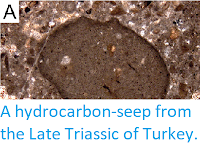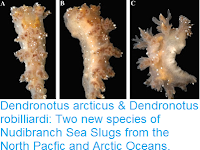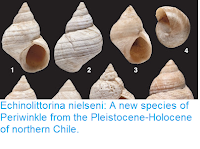Nudibranch Sea Slugs are marine Gastropod Molluscs that lose their shells during their larval stage. Like other Sea Slugs (not all of which are closely related) they are often colourful and have feathery external gills, and while often hard to tell apart from these other Sea Slug groups, can be distinguished by morphological examination. All Sea Slugs are externally biliterally symetrical, however Nudibraches are Opisthobranches (members of the same Gastropod group as the terrestrial Pulmonate Snails), and lack internal symmetry. This is manifested externally in the positioning of the sexual openings, with both male and female openings on the right side of the body. Almost all Nudibranches are benthic (live on the sea floor or other surfaces) and are found from the intertidal zone to the abyssal ocean floors, though most species are found on shallow tropical reefs.
The Nudibranch Platydoris angustipes is considered to be widespread in the western Atlantic, being found from the Caribbean in the north, south to the coast of Brazil and east as far as Ascension Island. However, the species was described from specimens collected in the Caribbean (the US Virgin Islands) and shows considerable morphological variation across its range, so it is not completely certain that it whether all populations assigned to Platydoris angustipes are in fact the same species.
In a paper published in the journal Zoological Systematics on 2 January 2018, Patricia Lima and Luiz Ricardo Simone of the Museu de Zoologia da Universidade de São Paulo describe a new, cryptic, species of Platydoris from the coast of Rio de Janeiro State in Brazil.
Cryptic species are species that closely resemble other species, and cannot be separated by simple, non-invasive examination. While taxonomists have known about cryptic species for a long time, it was not realised how numerous such species were until taxonomists began to use genetics to determine relationships between species, about twenty years ago. The presence of cryptic species can have a profound influence on conservation efforts, as ‘species’ thought to be wide ranging with large populations and broad environmental tolerances can turn out to be complexes of closely related but reproductively isolated species, each with a smaller population and distribution, and narrower range of environmental tolerances.
The Brazilian and Caribbean populations of Platydoris angustipes have previously been suggested to be different in several ways, including the colour and shape of the body, the length of the foot, the covering of the dorsal surface, the nature of the oral tentacles, and the number of gills branches. However, Lima and Simone found that all these features are variable in both populations, and that while the two populations show different frequencies of all these traits, none of them could be reliably used to assess which population an individual specimen came from.
Nevertheless, it did prove possible to different the two populations, based upon on several important morphological differences. Firstly, the shape of the radula (tongue) is different in the two populations, with the Caribbean populations having a straight-sided radula and the Brazilian populations having a radula distinctively wider at the base (radula shape is considered an important diagnostic feature in all Gastropod groups). Secondly, the renal vesicles (kidneys) of the Brazilian population are much larger. Thirdly the digestive tract of the two populations is arranged differently, with the Brazilian population having shorter odontophore muscles and a shorter cecum. Finally, the reproductive systems of the two populations are quite different, with the Brazilian population lacking spines on either the penis or vagina, unlike the Caribbean population, and indeed any previously described species of Platydoris. The structure of the reproductive tract is particularly important for establishing species boundaries in all animal groups that mate internally (as opposed to releasing eggs and sperm into the environment), as populations with different reproductive apparatus typically cannot mate.
In a paper published in the journal Zoological Systematics on 2 January 2018, Patricia Lima and Luiz Ricardo Simone of the Museu de Zoologia da Universidade de São Paulo describe a new, cryptic, species of Platydoris from the coast of Rio de Janeiro State in Brazil.
Cryptic species are species that closely resemble other species, and cannot be separated by simple, non-invasive examination. While taxonomists have known about cryptic species for a long time, it was not realised how numerous such species were until taxonomists began to use genetics to determine relationships between species, about twenty years ago. The presence of cryptic species can have a profound influence on conservation efforts, as ‘species’ thought to be wide ranging with large populations and broad environmental tolerances can turn out to be complexes of closely related but reproductively isolated species, each with a smaller population and distribution, and narrower range of environmental tolerances.
The Brazilian and Caribbean populations of Platydoris angustipes have previously been suggested to be different in several ways, including the colour and shape of the body, the length of the foot, the covering of the dorsal surface, the nature of the oral tentacles, and the number of gills branches. However, Lima and Simone found that all these features are variable in both populations, and that while the two populations show different frequencies of all these traits, none of them could be reliably used to assess which population an individual specimen came from.
Nevertheless, it did prove possible to different the two populations, based upon on several important morphological differences. Firstly, the shape of the radula (tongue) is different in the two populations, with the Caribbean populations having a straight-sided radula and the Brazilian populations having a radula distinctively wider at the base (radula shape is considered an important diagnostic feature in all Gastropod groups). Secondly, the renal vesicles (kidneys) of the Brazilian population are much larger. Thirdly the digestive tract of the two populations is arranged differently, with the Brazilian population having shorter odontophore muscles and a shorter cecum. Finally, the reproductive systems of the two populations are quite different, with the Brazilian population lacking spines on either the penis or vagina, unlike the Caribbean population, and indeed any previously described species of Platydoris. The structure of the reproductive tract is particularly important for establishing species boundaries in all animal groups that mate internally (as opposed to releasing eggs and sperm into the environment), as populations with different reproductive apparatus typically cannot mate.
The radula of (left) a specimen of Platydoris angustipes from the US Virgin Islands, and (right) Platydoris sp. from Rio de Janeiro State, Brazil. Scale bars are 100 μm. Lima & Simone (2018).
The new species is named Platydoris guarani, in honour of the Guarani indigenous people of Rio de Janeiro State. These Sea Slugs are typically about 60 mm in length and 40 mm in width, with a rounded body, and are usually orange in colour with a white ribbon around their edges, and a row of brown spots just above this. The dorsal surface is covered in small tubercles, and the gills typically have six white branchial leaves.
Lima and Simone suggest that all Brazilian populations of ‘Platydoris angustipes’ should in fact be assigned to ‘Platydoris guarani’, but are uncertain as to the status of the Ascension Island populations, and suggest that this should be investigated in the future.
See also...
Platydoris guarani, living animals. (A) Dorsal view, specimen from Papagaio, Cabo Frio, Rio de Janeiro. (B) Same specimen in ventral view. (C) Living animal with spawning, specimen from Enseada da Meia Lua, Cabo Frio, Rio de Janeiro. Vinícius Padula in Lima & Simone (2018).
See also...
Follow Sciency Thoughts on Facebook.








